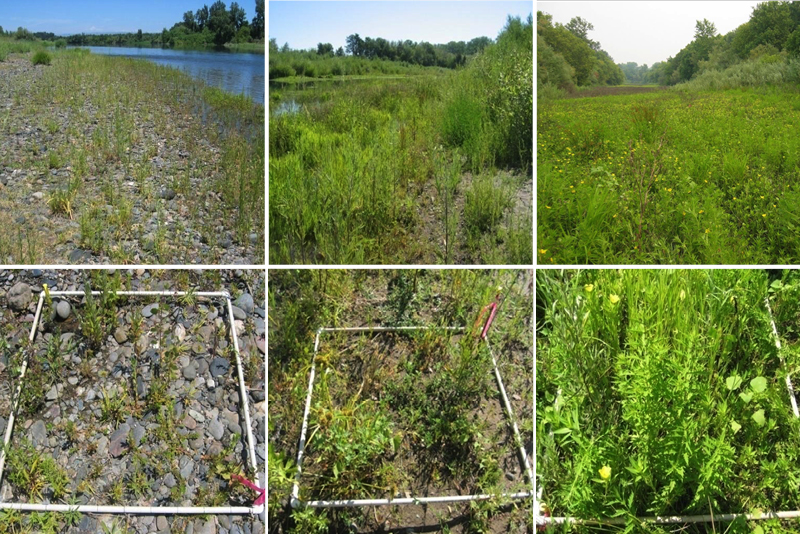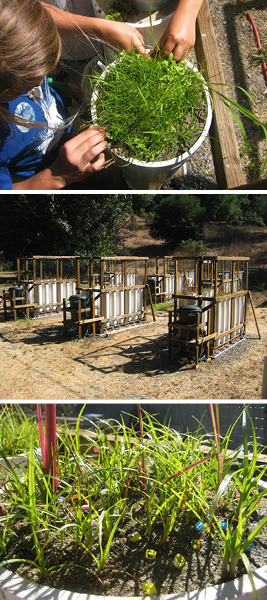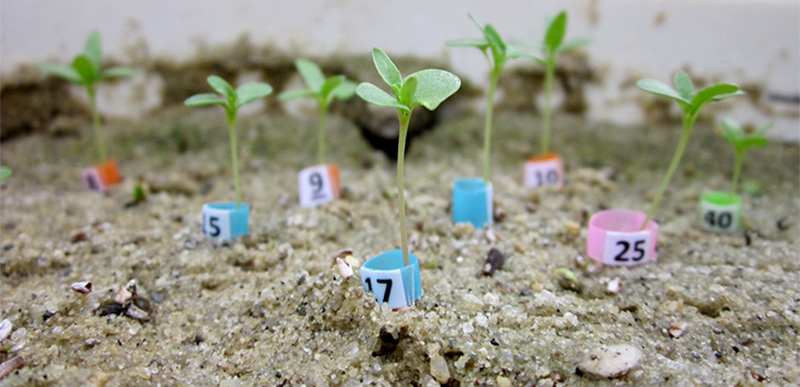By Maya Hayden, ESPM Graduate Student
It’s ironic—while the focus of so much environmental attention these days relates to how species and ecosystems are going to respond to all the changes we are throwing at them, certain species that thrive on change find themselves living in an artificially stabilized world, with equally problematic results.

A segment of the middle Sacramento River flowing through the predominantly agricultural valley, showing point bars and abandoned channels that have filled in with sediment and vegetation. Photo credit: USDA National Agriculture Imagery Program, 2004.
River systems are a great example. There’s that old saying that “no man steps into the same river twice.” This is very true; rivers are naturally dynamic, and the streamside, or riparian, plant species that live along their banks have adapted to the ever-shifting landscape that results from cycles of flooding and summer drought. These flood cycles can be described by their timing, magnitude, frequency, and duration, collectively referred to as the flood “disturbance regime.” Water has direct effects on plants, as well as indirect effects mediated by the stuff that it picks up and moves around (e.g., sand and gravel that gets eroded, transported, and deposited during floods). In rivers that meander across wide valley bottoms, like those found in California’s Central Valley, the path of a river naturally shifts course and wanders back and forth across its floodplain. In some bends in the river, the river moves a little bit each year, eroding the outer bank and “growing” the inner one (called a point bar). Periodically, though, the path of the river shifts dramatically, and a bend of the river channel gets cut off and “abandoned” by the main flow of water (see time lapse images below). The result of both processes is the creation or renewal of patches of cleared land, upon which new vegetation can germinate and grow.
Time lapse showing the process of channel meander, channel cutoff, and abandonment in a reach of the Ucayali River in Peru (a tributary to the Amazon). The channel that gets “abandoned” remains as what’s often referred to as an “oxbow lake.” You can also see the remains of older abandoned channels that have filled in with sediment and vegetation—they look a bit like scars on the landscape. (Source: Google Earth Engine).
On this cleared land along both the main channel and the abandoned channels of a river, the new plants that begin to grow are typically good “pioneers” – the early arrivers that have strategies to deal with lots of environmental stresses. Later, the “resource competitors” will arrive – plants that can compete with established vegetation for resources such as nutrients, water, or light. Like the settlers that fanned across the plains during westward expansion, pioneer riparian trees like cottonwoods and willows are particularly hardy and well suited to the unpredictable life of a changing river. Due in part to their fast growth and large size, these pioneer tree species provide important structure and function, for example, in food web dynamics, nutrient cycling, erosion control, and as a habitat for fish (as trees and branches fall into the river) and wildlife.
However, pioneer riparian trees like cottonwoods and willows that depend on flood disturbances for regeneration opportunities have been declining. These declines are a direct result of human activity. Through floodplain land use changes and water flow regulation from dams built for water supply, flood control, and power generation, the dynamic rivers of much of the Western U.S. (and worldwide) have been stabilized. This stabilization is beneficial from a human perspective, but does also affect the trees: cottonwood seedlings that would normally germinate and grow along the main channel of a river with natural flood cycles typically don’t survive past the first summer growing season anymore. Without the underlying processes that allow for new seedlings to survive and mature, someday there may not be enough young trees to replace the aging ones, and eventually we may lose them from the system altogether.

Examples of how conditions change through time in an abandoned channel—from coarse, relatively bare ground on what used to be a point bar, to fine sand and silt covered by dense vegetation. Unless otherwise noted, photos by Maya Hayden.
Most of the research and discussion about the future of pioneer tree species in rivers has focused on the main river channel, with little attention paid to the pioneer trees that do grow in abandoned river channels. As a graduate student in Professor John Battles’ forest ecology lab, I’ve spent much of my graduate work turning the focus to abandoned channels to begin to understand how important they are in supporting the long-term persistence of pioneer riparian forests. As part of a collaborative study with an interdisciplinary group of researchers from SUNY ESF and the National Center for Scientific Research in France, I examined how much of the current forest area established in areas of a river that were already abandoned (which hadn’t been quantified before), and worked to identify the mechanisms that control seedling survival in these areas. Using time-series historical aerial photos, I documented that over half of the area of existing stands of cottonwood forest growing along the 100-km middle reach of the middle Sacramento River began life as seedlings in abandoned channels, as opposed to along the banks of the main channel. This suggests that in an altered river system, this secondary location for forest regeneration is hugely important.

Mesocosm experiment testing effects of two main environmental variables (water availability and competition with herbaceous wetland plants) on cottonwood seedling growth and survival.
Once we established that many pioneer trees are establishing in abandoned channels, I began to investigate how this process happens. Because abandoned channels remain only partially connected to the main flow of water, they are disturbed with less frequency and intensity. This leads to all sorts of changes over time that, from a plant perspective, make life in an abandoned channel pretty easy relative to the rugged life along the main channel. The result is great for tree seedlings trying to establish themselves, but also for all kinds of other plants too—and that creates competition among the various species. So an important question of my research was, will the pioneering cottonwoods be able to regenerate in these abandoned channels when faced with heavy competition from all kinds of other wetland species?
To explore this question, I and a team of awesome Cal undergrads tracked about 10,000 cottonwood seedlings in a series of community mesocosm experiments. In a mesocosm, we try to replicate natural conditions in a controlled environment. In my experiments, we recreated the range of environmental conditions that we had quantified in the field along the Sacramento River, including the range of substrate grain sizes (from coarse gravel to very fine sand), and the “competition” gradient from bare ground to dense cover of herbaceous wetland plants. We then mimicked the water table decline that typically occurs in the river over the summer growing season, inducing a natural water stress gradient. Through these experiments, we found that some cottonwood seedlings can survive even in a pretty densely vegetated area as long as there is a reasonable amount of water available, and they are much more tolerant of shading than previously thought. While our results predict survival is low, you only need periodic establishment of a new stand of cottonwoods to maintain the broader population as a whole.

The good news is that even in relatively “stabilized” river systems like the Sacramento, abandoned channels continue to form periodically where the channel is unconfined. And when they do, our research predicts that cottonwoods are almost always going to become established and live for a long time, providing a population from which offspring can continue to spread.
